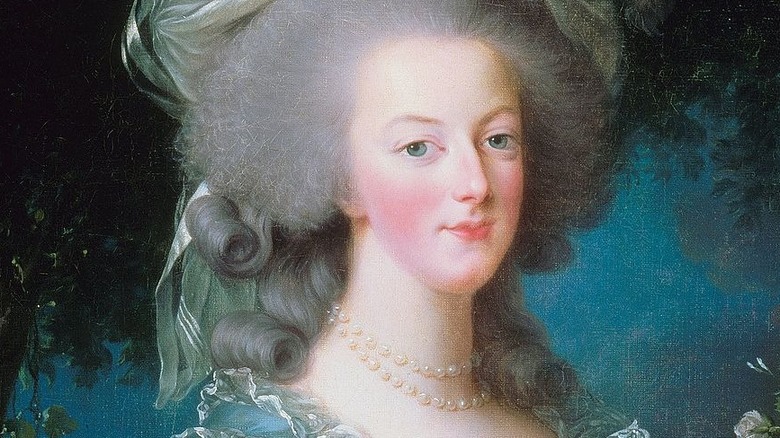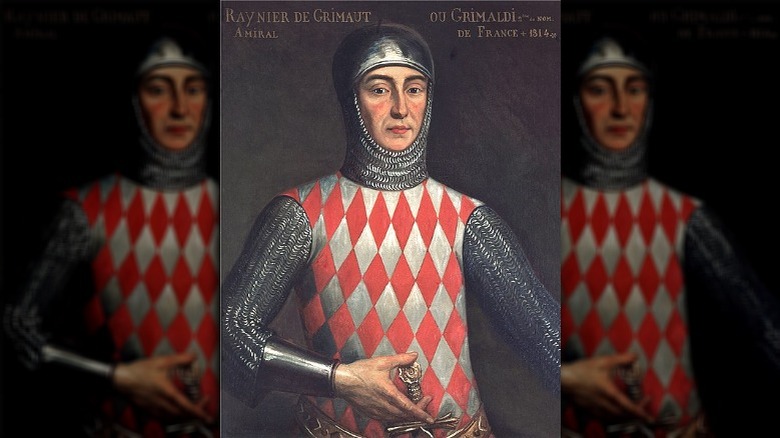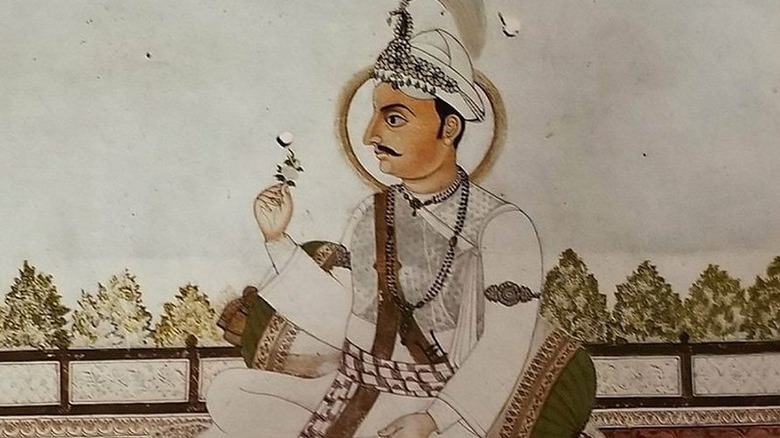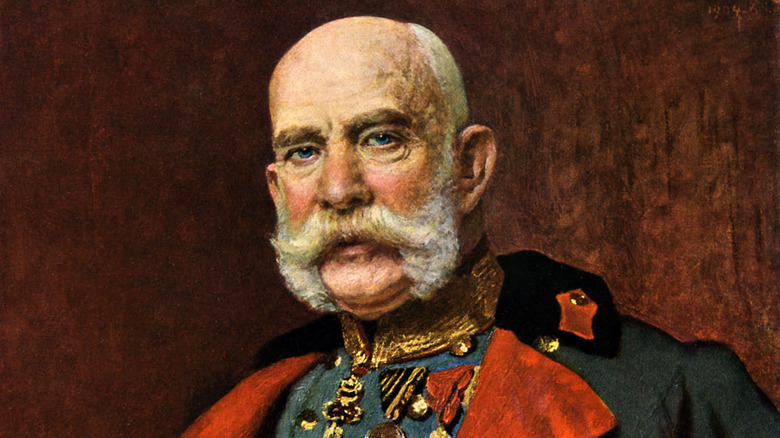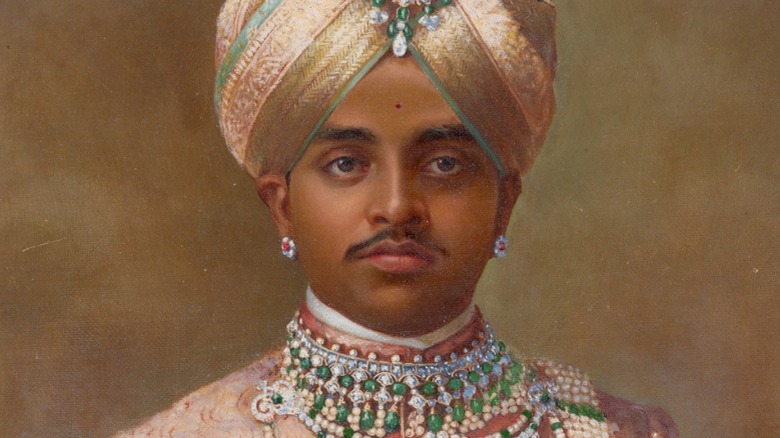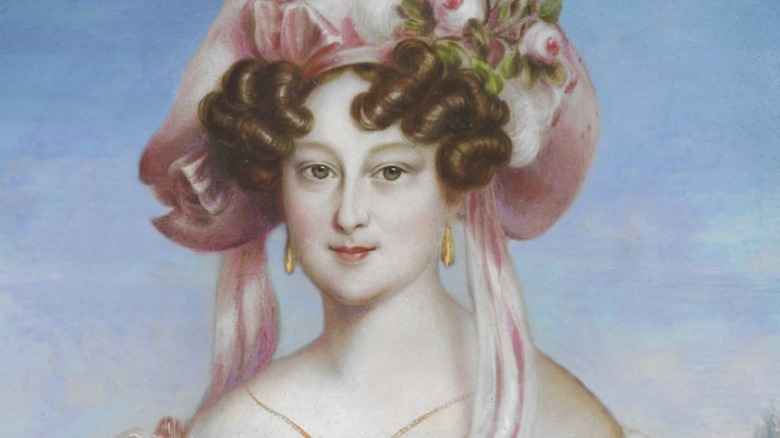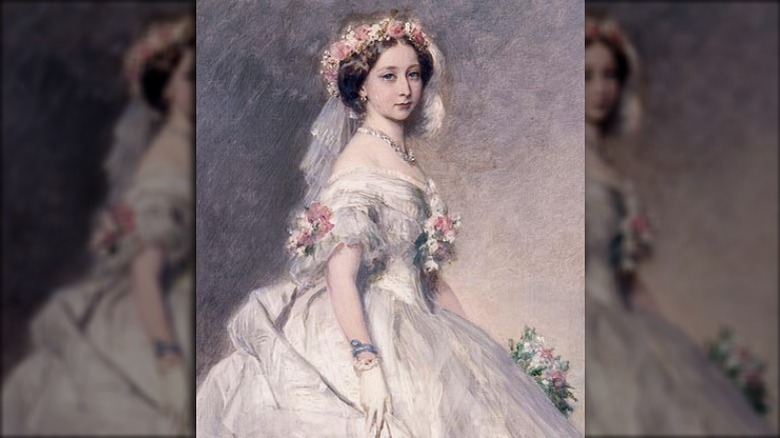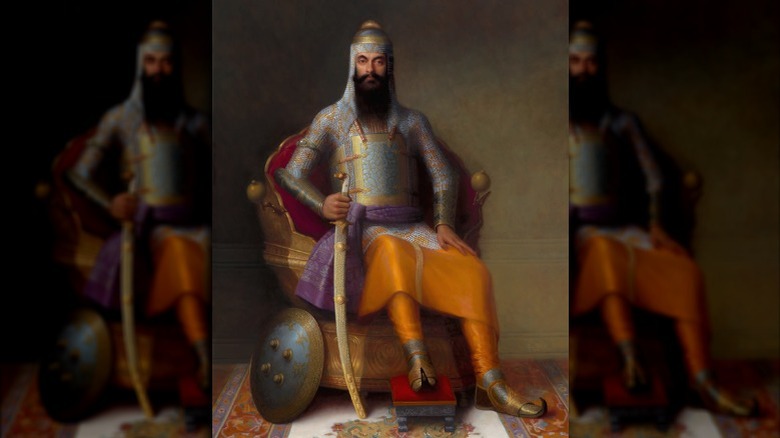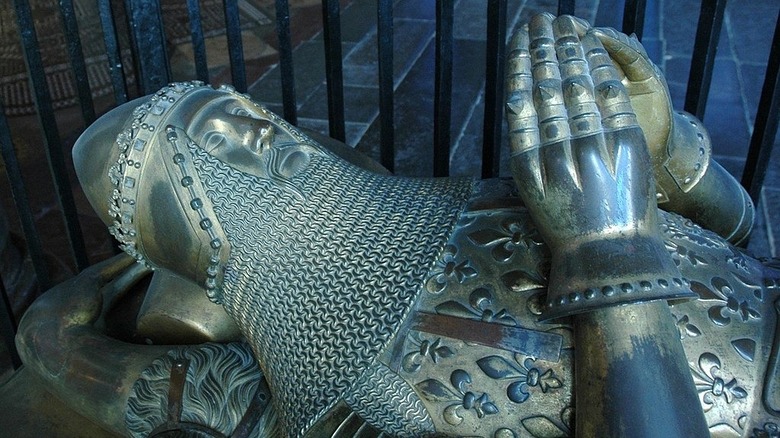The Most Famous Curses In Royal History
Who wouldn't want to be a royal? You get to live in palaces, have a bunch of servants, never have to worry about running out of money, all in exchange for waving and cutting a ribbon once a week or so. You aren't even forced to marry your cousin anymore, usually. Sure, there's a lack of privacy and control over your own life ... but the tiaras! Think of the tiaras!
But even if the financial security sounds like it would be worth some of the downsides, you still might want to reconsider any marriage proposals from the princes of far-flung lands. After the big wedding and exotic honeymoon, when you get home and take the tiara off, you might discover those palaces aren't as luxurious as they seem, that walking through the labyrinthine halls you feel something ... unwelcome. Only then will the glamorous prince tell you the true story of his august family -– that it has been haunted by a terrible curse for centuries.
It turns out, a lot of the most famous royals in the world have legends of a family curse, brought on by witchcraft, dark past deeds, gemstones, or even genetics. And while you might think the notion of an actual, malevolent force able to reach through the generations sounds ridiculous, the continual and overwhelming tragedies suffered by these royal families might make you think again.
The Grimaldi family was cursed by a witch
The Grimaldis are the ruling family of Monaco, the one Grace Kelly married into, which resulted in her becoming Princess Grace. But the Grimaldi family, which has been ruling Monaco since 1297, has suffered under a curse since the beginning. According to Tatler, there are a couple different versions of how it began. Either Prince Rainier I (pictured) abducted a Flemish woman who was really not happy about that turn of events and became a witch afterwards, or there was a witch being burned at the stake. Whomever it was, the unhappy woman is said to have gotten revenge by laying out the curse plainly: "Never will a Grimaldi find happiness in marriage."
A look at the recent Grimaldi family relationship record makes it hard to think the curse isn't still in effect. While Grace Kelly and Prince Rainier III were sold to the public as a great love story, the truth was a lot more complicated than that, and he cheated on her with many women. Prince Rainier's father was gay and ended his unhappy marriage after 10 years. Rainier's children fared no better. Princess Caroline has been married three times: divorced after two years, widowed at just 33 years old, and now separated. Princess Stephanie married twice, with neither union lasting even two years.
Perhaps taking the curse seriously, the current reigning prince, Albert II, put off marriage for a long time, instead having a few children outside of marriage by a few different women.
The Nepalese royal family curse
The Nepalese royal family's curse seems especially unfair. According to the New York Times, Nepal became a sovereign nation in the 1700s, ruled by Prithvi Narayan Shah (pictured). One day, the king offered a hermit a bowl of curd. It must have been pretty shocking when the hermit drank the curd ... then vomited it all back up right at the king. The king moved to avoid it and for that, his family was cursed. See, the hermit was really the god Gorakhnath, and he was offended that the king dodged his puke. The curse said Nepal's monarchy would last 10 generations before coming to a sudden end.
Unfortunately, the curse came true in the most horrific way possible. On June 1, 2001, the then-king of Nepal, Birendra Bir Bikram Shah Dev, and most of his family were together in Narayanhiti Palace. For reasons that are still not clear, Prince Dipendra, the king's son and heir, entered the room loaded with weapons and opened fire. He killed nine people, including his father, mother, brother, and sister.
Dipendra then tried to kill himself, but ended up in a coma. He lingered for two days, during which, because of how monarchies work, he was officially Nepal's king. It's thought he might have been upset about not getting to marry the woman he wanted to, although according to friends (via The World) the crown prince was always "sadistic" and unhappy. The crown passed to Birendra's brother before Nepal ended its monarchy in 2008. It lasted exactly 10 generations.
The Habsburg's curse
Perhaps no royal family has had more curses placed on it than the Habsburgs (sometimes spelled Hapsburgs). The infamous Archduke Franz Ferdinand, whose assassination in 1914 led directly to World War I, was a member of this family. According to Riverside Daily Press, when he heard of his nephew's horrible death, Emperor Franz Joseph I is said to have shouted, "Horrible! horrible! Will no horror be spared to me?" While that might seem a bit self-centered, the emperor had seen an unusual amount of tragedy in his life, as had his ancestors.
So what curse caused all that pain? The Vintage News says that it might be the Turnfalken, supernatural ravens who started showing up whenever anything bad was about to happen to a Habsburg. They were said to be taking revenge for a broken promise to protect ravens after some of them saved a Habsburg prince's life.
Or it could have been Emperor Franz Joseph's personal curse, laid on him by the mother of a teenager he had executed. The Countess Karolyi hexed the ruler, saying, "May heaven and hell blast your happiness! May your family be exterminated! May you be smitten in the persons of those you best love! May your children be brought to ruin, and may your life be wrecked, and yet may you live on in lonely, unbroken and horrible grief to tremble when you recall the name of Karolyi!" Harsh, but probably fair.
The Wadiyar family curse
The Wadiyar (also spelled Wodeyar) royal family ruled over Mysore in India, but they only got the throne by force, and that resulted in one of the most specifically effective curses ever laid on a royal family. According to India Today, when Raja Wadiyar deposed the ruler Tirumalaraja in 1612, the latter's wife, Alamelamma, escaped loaded down with valuables. When Wadiyar's men caught up with her, she threw herself into a river, calling down the curse: "May Talakadu be filled with sand and become a barren land/ May Malangi ... turn into a whirlpool/ may the Wodeyars never have children." All three parts of the curse came true.
Even respected intellectuals think it's super weird that, as India Today records, "ever since, the Wodeyars have birthed male children only in alternate generations." Historian Dr. A. Veerappa explains, "If we take a scientific view, there is no scope for a curse. But if you observe the Wodeyar family tree, six rulers since the 17th century have been adopted sons [nephews]. The Wodeyars too acknowledge it as fact."
But has the curse finally been broken? In 2017, India TV reported that the current ruler –- himself an adopted son –- and his wife welcomed the first Wadiyar baby in 54 years: a son. The family took to Instagram, posting, "Very Happy to share this picture of The Rajmata, Pramoda Devi Wadiyar, along with her grandson, The Yuvaraja." Fingers crossed for the little guy.
The Coburg-Kohary curse
Hemophilia has affected almost all the royal families of Europe, thanks to Queen Victoria. According to "Royal Babylon: The Alarming History of European Royalty," she had nine kids and married them off to various noble or royal families, and some of them inherited the gene that carries the disease. "The History of Medicine" says that all the subsequent intermarrying between cousins meant the chances of hemophilia presenting was much greater than in the general population. One of Queen Victoria's own sons was a hemophiliac as well. At the time, this was a death sentence. Hemophilia makes it difficult for blood to clot, which means almost any wound could be fatal, causing an agonizing death.
Queen Victoria didn't want to believe she could have given her son hemophilia, even though scientists looking at her family's history are pretty sure it came from a spontaneous mutation in the DNA of either her or her father. While she tried to blame her husband's side of the family (which is weird, since they were first cousins, so from the same family), Queen Victoria knew about the curse supposedly put on her own ancestors.
One of the German branches of Queen Victoria's family were the Coburgs, who were famously cursed. The extremely rich Hungarian noble Antoinette de Kohary (pictured) married into the family in 1815. A Kohary relative, a monk, was so jealous of the wealth she and her husband inherited at their wedding that he cursed the family with disease, which might have finally presented in Queen Victoria's children and grandchildren.
The curse on the House of Hesse
It's not clear where the curse that befell the grand duchy of Hesse-Darmstadt came from, but The Court Jeweler points to the Strawberry tiara as the culprit. It certainly fits. The tiara was designed by Prince Albert, husband of Britain's Queen Victoria, for their daughter Princess Alice (pictured) to wear on her wedding day. But before he could see her walk down the aisle in it, Albert died of typhoid fever, aged just 42.
Alice wore the tiara at her wedding and brought it to Hesse. But tragedy followed her. Exactly 17 years to the day after her father died of the disease, Alice died of typhoid, but not before watching one of her daughters suffer and die of it as well. What Alice left behind, though, was an even worse disease. She unknowingly carried the gene for hemophilia (from her mother, Queen Victoria), and through her daughters Alice passed it onto the Spanish and Russian royal families, with tragic results.
Perhaps none of that was down to a curse on the Strawberry tiara. But then in 1937, five members of the Hesse ducal family were flying to a relative's wedding when their plane crashed while trying to make an emergency landing (via Time). Everyone on board was killed, including two young children. When the crash site was searched, a premature baby, also dead, was found next to the 26-year-old grand duchess Cecile, compounding the tragedy. The Strawberry tiara was recovered from the wreckage of the plane.
Marie Antoinette and the Hope Diamond curse
Legend says that the Hope Diamond, now in the Smithsonian, is probably the most cursed stone in all of history. Unfortunately, a whole lot of the legend was made up as part of a sales pitch by famous jeweler Pierre Cartier in 1910, according to ThoughtCo. However, that's not to say none of the stories of the curse are true. And plenty of the people who have come to bad ends while in possession of the Hope Diamond have been royalty.
In 1668, the French king Louis XIV acquired the stone from a jeweler, who had purchased it in India. Mental Floss says that Louis loaned it to a friend for a special occasion, but then that friend fell out of favor with Louis and was jailed for 15 years. Louis lost all but one of his children in childhood, and he himself died a painful death from gangrene. The Hope Diamond was still part of the crown jewels when Louis XVI and Marie Antoinette were arrested and thrown in jail, although by the time they were executed, the giant rock had been looted. The queen's best friend, Marie-Louise, Princess de Lamballe, was literally torn apart by a mob.
Cartier's almost certainly untrue embellishments to the Hope Diamond's cursed history included that the Russian Prince Kanitovsky gave his lover the diamond and subsequently murdered her, and that Sultan Abdul Hamid of Turkey lost his throne and his lover after buying the stone.
The Koh-i-Noor curses male royals
The Koh-i-Noor is a massive diamond, currently part of the British Crown Jewels collection. However, it didn't originate anywhere near the British Isles. According to the World History Encyclopedia, no one is quite sure when or where it originated. Some people think it's mentioned in texts as old as the fourth century B.C., and most accept that it was mined on the Indian subcontinent sometime between 1100 and 1300.
A stone so big was only fit for a king, and we know that by either the mid-1500s or mid-1600s, the Koh-i-Noor was displayed in the Mughal royal family's peacock throne. The stone spent 150 years being passed around between rulers on the subcontinent, but they all seemed to have misfortune befall them.
In 1849, the East India Company won the Anglo-Sikh Wars and demanded the Koh-i-Noor as part of the peace treaty. They then arranged for it to be given to Queen Victoria. According to legend, the Indians sent a note with their royal rock, "He who owns this diamond will own the world, but will also know all its misfortunes. Only God or Woman can wear it with impunity." True or not, the British press loved the idea of a curse and gave it lots of column inches. The royal family seems to have taken it seriously, as well. Since they "acquired" the diamond, it has only been set in jewelry pieces and small crowns meant for queens.
The Black Prince's cursed ruby
The stone now known as the Black Prince's ruby is part of the British royal family's Imperial State Crown. It's also not a ruby: it's a spinel. But it's still huge and essentially priceless. Oh, and it's cursed.
According to Gem Select, the Black Prince's not-ruby was probably mined in present-day Tajikistan, eventually ending up in Spain by 1300 in the possession of the Moorish Prince Abu Sa'id. At this time, the Moors ruled part of the Iberian peninsula, and the Christian ruler of Castile, Don Pedro, was trying to get it back. When Abu Sa'id agreed to surrender, Don Pedro invited him and his entourage to a castle to hammer out the details. Instead, the Spaniards slaughtered all of them. Legend says Don Pedro killed Prince Abu Sa'id himself, then searched his dead body for valuables and found the impressive stone.
But Pedro wouldn't have it for long. Forget the Moors, it was his own family he had to worry about. Pedro's half-brother, Henry of Trastamara, attacked Castille, and Pedro looked to England for help. Edward III's oldest son, also named Edward and known as "the Black Prince," came to help out, and left with his now-namesake "ruby" as part of his payment. As for the curse? Don Pedro died within three years, the Black Prince died a painful, lingering death before he could become king, and his son, Richard II, died aged 33 after losing his throne.
The Tokugawa curse
Even before it was delayed for a year, and almost canceled entirely, the Tokyo 2020 Olympic Games were running into lots of trouble. Japan Times says this reminded people about the curse supposedly placed on Tokyo, and the area around the Olympic stadium in particular: the Tokugawa curse.
According to the Guardian, in the 10th century, a man named Masakado, who was posthumously dubbed the "first samurai," decided he'd been chosen by the Sun Goddess to be emperor. The actual emperor was not happy about this, especially when Masakado took over two provinces. A bounty was put on his head, and Masakado was subsequently killed. But rumors spread about him: his mother was a serpent, his head howled for its body and flew away, butterflies and rainbows had appeared right before his rebellion. His daughter moved into Masakado's ruined fortress, where she took up necromancy and built an army of frogs.
What Masakado had really done, though, was show the emperor wasn't all-powerful. Soon others rose up, and the Tokugawa Shogunate ruled Japan for the next 250 years, emperors in all but name. Once they were overthrown in 1868, everything bad that happened in the area near Masakado's grave was blamed on his curse. And, in an interesting connection to 2020, Prince Tokugawa Iesato, head of the no-longer-in-charge Tokugawa family, was tasked with organizing the 1940 Tokyo Olympics. If you wonder why you've never heard of those Games, it's because they were canceled by World War II.
The Zulu royal curses
Princess Mkabayi Kajama should have been murdered as soon as she was born, according to Face 2 Face Africa. The Zulu people had a belief that twins were cursed, but Mkabayi and her twin sister Mmama were allowed to live by their father, King Jama. His subjects were not impressed and proceeded to blame everything bad that happened to the Zulu on the curse the sisters carried. They even blamed them when their own mother died, which was bad news for the tribe, because she hadn't provided a male heir yet.
Mkabayi continued to buck tradition. When her father died, she became regent for her young half-brother, even though no woman had ever held that position before. The Zulu called her a "bloodthirsty despot," although she did step down voluntarily when her brother was old enough. Twenty years later, his son Shaka Zulu (pictured), Mkabayi's nephew, would ascend to the throne.
Shaka was both a very successful king and very, very violent. He had a thing for killing his own people by the thousands for no reason. So Mkabayi arranged for his brothers to kill him. As he died, legend says he cursed the Zulu: "You will never rule this land, it will be ruled by the sparrows, who will fly across the sea and build their nests high up on cliffs." It's said this curse brought the white invaders who overthrew the next king. The curse of Mkabayi led to the curse of Shaka, which led to the defeat of the Zulu.
